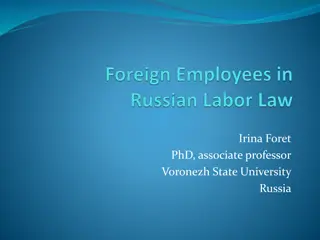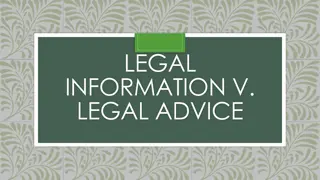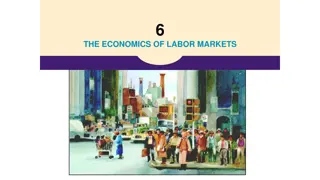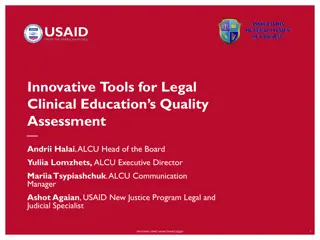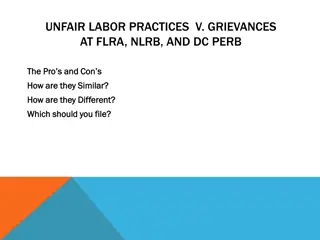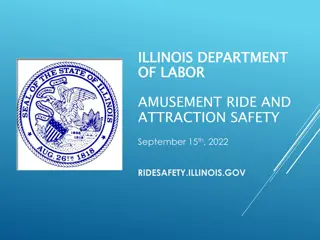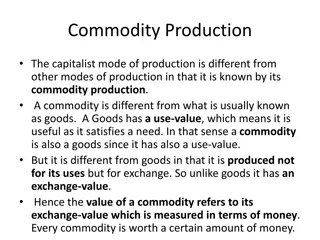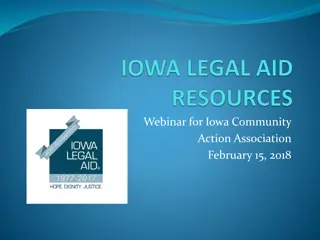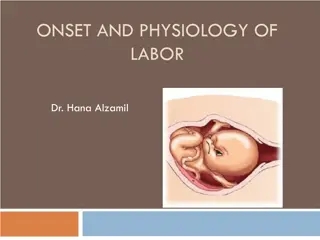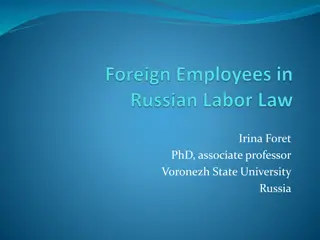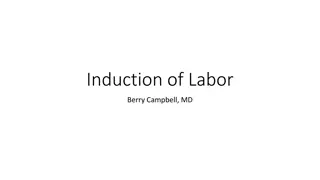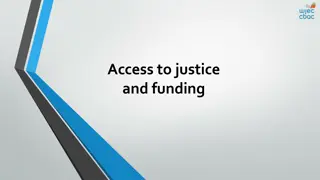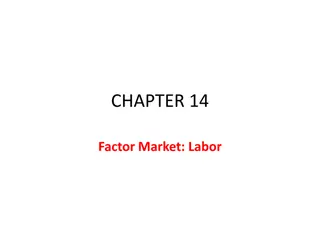Legal Updates on Department of Labor Developments
This presentation covers recent legal developments regarding the Department of Labor, including the invalidation of the 2024 Final Rule on overtime exemptions. Key takeaways, court decisions, and implications for employers are discussed.
Download Presentation

Please find below an Image/Link to download the presentation.
The content on the website is provided AS IS for your information and personal use only. It may not be sold, licensed, or shared on other websites without obtaining consent from the author.If you encounter any issues during the download, it is possible that the publisher has removed the file from their server.
You are allowed to download the files provided on this website for personal or commercial use, subject to the condition that they are used lawfully. All files are the property of their respective owners.
The content on the website is provided AS IS for your information and personal use only. It may not be sold, licensed, or shared on other websites without obtaining consent from the author.
E N D
Presentation Transcript
This presentation is designed to provide general information on pertinent legal topics. The information is provided for educational purposes only. Statements made or information included do not constitute legal or financial advice, nor do they necessarily reflect the views of Holland & Hart LLP or any of its attorneys other than the author. This information contained in this presentation is not intended to create an attorney-client relationship between you and Holland & Hart LLP. Substantive changes in the law subsequent to the date of this presentation might affect the analysis or commentary. Similarly, the analysis may differ depending on the jurisdiction or circumstances. If you have specific questions as to the application of the law to your activities, you should seek the advice of your legal counsel.
1. Department of Labor Developments 2. Non-Competition and Other Restrictive Covenants 3. Pregnant Worker Fairness Act 4. Spike in Wage Claims 5. Artificial Intelligence in the Workplace 6. Best Practices for ADA and FMLA Scenarios 7. DEI Policies What is the Law 8. Questions?
State of Texas v. Dept of Labor, Case No. 24-cv-468-SDJ On November 15, 2024, the U.S. District Court for the Eastern District of Texas invalidated the Department of Labor s (DOL) 2024 Final Rule, which increased salary thresholds for overtime exemptions under the Fair Labor Standards Act (FLSA).
The Courts Decision: In its ruling, the court determined that the DOL exceeded its authority by allowing salary levels to overshadow the duties test central to the EAP exemption. The court also cited the Supreme Court s 2024 decision in Loper Bright Enterprises v. Raimondo, which clarified that courts must independently determine whether an agency acted within its statutory authority.
Key Takeaways: Executive, Administrative, and Professional (EAP) Exemptions The planned salary threshold increase to $844 per week (or $43,888 annually), effective July 1, 2024, is no longer valid. Future staged increases, including the January 1, 2025 threshold of $1,218 per week and automatic updates starting July 1, 2027, are also void. Highly Compensated Employee Exemption The planned salary threshold increase to $132,964 effective July 1, 2024 is no longer valid. Future staged increases, including the January 1, 2025 threshold increase to $151,164, is now void.
1. Reversion to Previous Rules. 2. Compliance Considerations for Employers who Raised Salaries. 3. Appeal Uncertainty. 4. Duties Test Remains Critical.
Roll-Back of Biden-Era Regulations. The new Trump DOL will look much like the old. Schedule F: Reinstatement of Schedule F a 2020 executive order that would reclassify thousands of federal workers as at-will employees is very likely. Immigration. A Trump DOL could potentially collaborate with other federal agencies on undocumented workers. This could result in worksite raids and heightened scrutiny on and requirements for employment eligibility. Independent Contractors. Shortly before President Biden was inaugurated, then-President Trump s DOL finalized easing the necessary requirements to classify workers as independent contractors.
Non-Competes Generally Under State Law Non-competes are currently allowed, with some exceptions, in Idaho, Montana, and Utah. Idaho Code 44-2701 et seq. Although Mont. Code 28-2-703 technically prohibits non-competes, courts have interpreted the law to allow for partial or reasonable non-compete agreements. Utah Code 34-51-201 et seq. However, other states including California, Minnesota, and North Dakota currently ban post-termination non-competes outright.
The New Federal Rule In January 2024, the Federal Trade Commission (FTC) proposed a new rule to end the enforcement of employee non-compete agreements across the United States. The rule generally bans an agreement that prevents the worker from seeking or accepting employment with a person, or operating a business, after the conclusion of the worker s employment with the employer.
Application of the Rule The rule applies to both current and future contracts and would prohibit employers from claiming or representing to an employee that they were bound by such an agreement. The rule requires all employers that use any agreement with a non-compete clause to take action to rescind the clause and to provide written notice to the employee or former employee.
Exceptions to the Rule The proposed ban is limited to traditional pure non-compete covenants. It s not a wholesale prohibition on all restrictive covenants. The FTC s supplementary materials provide that other restrictive covenants such non-solicitation agreements are not expressly precluded.
Status of the Rule On April 23, 2024, the FTC approved the rule banning non-compete agreements. The rule was set to go into effect on September 4, 2024. On August 20, 2024, a Texas Court issued a nationwide injunction preventing the FTC from enforcing the rule. The FTC filed an Appeal to the Fifth Circuit on October 18, 2024 (likely to be decided 7-8 months from the filing). So, now what ..
Overview: Passed in 2023, the federal PWFA was introduced to combat discrimination and promote workplace equality by requiring employers to provide reasonable accommodations to employees and applicants with known limitations related to pregnancy, childbirth, or related medical conditions. Retaliation against such workers is prohibited.
The EEOC has been increasingly active in addressing compliance with regulations affecting pregnant workers. State labor commissions, such as the Idaho Human Rights Commission and the Utah Antidiscrimination and Labor Division, have likewise seen an increase in charges by pregnant workers.
Some employers have been caught off guard since pregnancy-related leave, without extenuating medical complications, has largely been a function of company parental leave policies, particularly where a worker has not been employed long enough to qualify for other leave. Employers need to take note that they are now required to engage in the interactive process to determine whether an employee is entitled to an accommodation for a pregnancy-related condition. In October of this year, a federal judge in Florida approved a nearly $100,000 settlement where an employer was accused of violating both the PWFA and Americans with Disabilities Act.
The incoming Trump Administration may also seek to limit the scope of protections afforded to employees under the PWFA.
Offer Letters, Compensation Plans, Employment Contracts Employee is eligible for an annual bonus of (x) Employee will be paid (x)% of gross profits Employee will be paid a quarterly bonus as set forth in the company bonus plan Employee will be paid a bonus based on amounts above revenue targets as set out in the following formula . . . Employee will be paid a commission in the amount of (x) if Employee achieves the following benchmarks . . .
Review your Offer Letters, Compensation Plans, Employment Contracts When is the compensation earned? When is the compensation due? What conditions precedent must occur for the employee to receive the compensation?
An employers use of AI must comply with existing employment laws. Both federal and state laws prohibit disparate treatment discrimination in the workplace (i.e., intentional discrimination of members of a protected class) and disparate impact discrimination (i.e., facially neutral practices or policies that may disproportionately affect members of a protected class).
Colorado. In May, Colorado became the first US state to enact comprehensive AI legislation. Effective February 1, 2026, the law applies to both developers and deployers (i.e., users) and requires the use of reasonable care to avoid algorithmic discrimination. Illinois. In August, Illinois passed a law (HB 3773) impacting employer use of AI technology. This law will go into effect on January 1, 2026. Employers will be required to notify employees when they use AI for employment decisions which include recruitment, hiring, promotion, renewal of employment, selection for training, discharge, discipline, tenure or the terms, privileges or conditions of employment.
These claims, more than any other, are a record keeping contest Get Employee requests to HR or your Administrator Don t grant informal leaves (no good deed goes unpunished) Train Supervisors and Managers Timely FMLA Certification (lets you start the clock) ADA Accommodation Questionnaire (have one on hand ready for use) Documentation of Undue Hardship, which can include a test period ***Remember leave can be an accommodation
Manager has Employee that asks for some time off for a personal health or family health matter. Manager allows the employee the time off. A further request happens and is granted. Soon, Employee has taken weeks of leave, but none is counted against the FMLA 12 weeks.
Employee is on FMLA. 12 weeks expired. Employer terminates employment without any thought of Employer s obligations under the ADA.
Employee informally requests an accommodation (although they don t call it that). Employer allows the request for a duration but grows weary of the arrangement. Employer later engages appropriate ADA accommodation steps, and Employer wants to claim, undue hardship. But Employer allowed the arrangement for a long period of time with no set limitations or parameters.
Employer has an under performing Employee. Employer has internally made the decision to terminate Employee on a date certain but has not documented the decision. Employee seeing the writing on the wall, requests FMLA leave.
Employer believes Employee has a disability, and unilaterally limits the Employee s duties or work hours, thinking they are doing what is best for the Employee.
Students for Fair Admissions, Inc. v. President and Fellows of Harvard College, 600 U.S. 181 (2023). Eliminating racial discrimination means eliminating all of it. -Roberts (majority) The pursuit of racial diversity will go on. - Sotomayor (dissent)
The Optimistic Take: SFFA has nothing to do with workplace DEI. Keep calm and carry on. The Pessimistic Take: Workplace DEI is now illegal.
Laws at issue in SFFA Equal Protection Clause: No State shall . . . deny to any person within its jurisdiction the equal protection of the laws. Title VI: No person in the United States shall, on the ground of race, color, or national origin, be excluded from participation in, be denied the benefits of, or be subjected to discrimination under any program or activity receiving Federal financial assistance. Laws affecting workplace DEI Title VII: It shall be an unlawful employment practice for an employer . . . to discriminate against any individual . . . because of such individual s race, color, religion, sex, or national origin. 42 U.S. Code 1981: All persons within the jurisdiction of the United States shall have the same right in every State and Territory to make and enforce contracts . . . and to the full and equal benefit of all laws . . . as is enjoyed by white citizens.
To make out a Title VII claim, a plaintiff must show some harm respecting an identifiable term or condition of employment. Terms or conditions are not limited to contractual terms, and cover more than the economic or tangible While a plaintiff must show some harm, the harm does not need to be significant, serious, substantial, or any similar adjective suggesting that the disadvantage to the employee must exceed a heightened bar.
Consider Risk Conduct a self-audit with your client to divide programs into risk zones of red, green, and yellow Factor in legal risks Factor in social and business risks Consider Impact Factor in the impact of the programs in achieving your client s DEI goals Decide How to Proceed All things considered, decide whether to maintain the program with awareness of risk, abandon the program with awareness of risk, or adjust the program to safeguard it
Avoid Preferences. From lifting to leveling - Rather than giving preference to some groups over others, think about DEI actions that are identity-neutral but help level the playing field: Creating a structured recruitment and promotion process with clear, transparent, merit-based criteria Purging stereotypical language from job descriptions and evaluation processes Reviewing employee benefits policies to ensure they are being applied equitably Putting managers through unconscious bias training before they consider candidates
Avoid Protected Groups. From cohorts to content Example: Expanding a racial equity program to welcome anyone who is committed to racial equity, regardless of their identity From cohorts to character Example: Asking candidates to write an essay explaining how race affected [their] life, be it through discrimination, inspiration, or otherwise From cohorts to cohorts Example: Developing initiatives that advance diversity and inclusion along lines of non-protected status, like socioeconomic status
Avoid Palpable Benefits. From adverse to ambient - rather than directly affecting people s conditions of employment (e.g., hiring and promotion), think about DEI programs that improve the overall culture of the organization, such as: Conducting employee education on topics such as bias, allyship, or inclusive leadership Creating a more physically inclusive office environment, such as through all- gender bathrooms, nursing rooms, and childcare facilities Building relationships with diverse professional groups (e.g., National Association of Black Accountants, Society of Hispanic Professional Engineers) Support community organizations focused on DEI issues, such as through volunteerism and philanthropy



